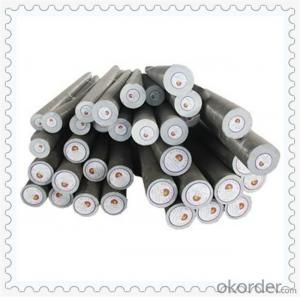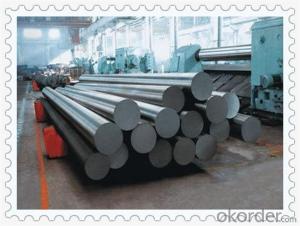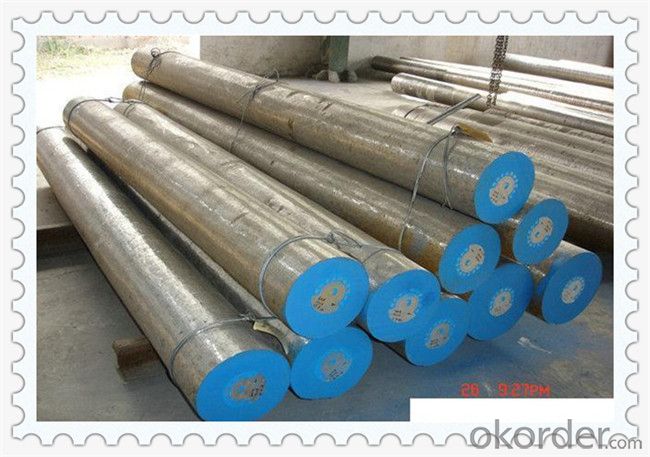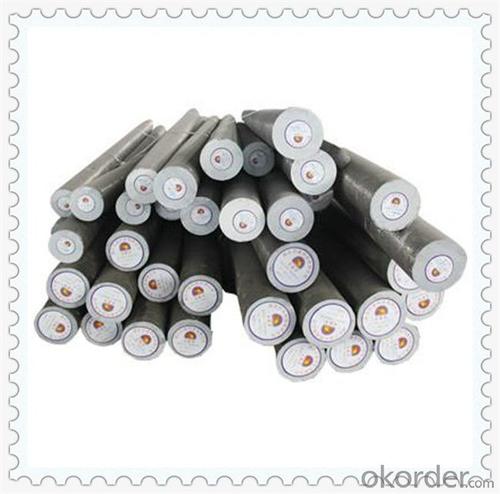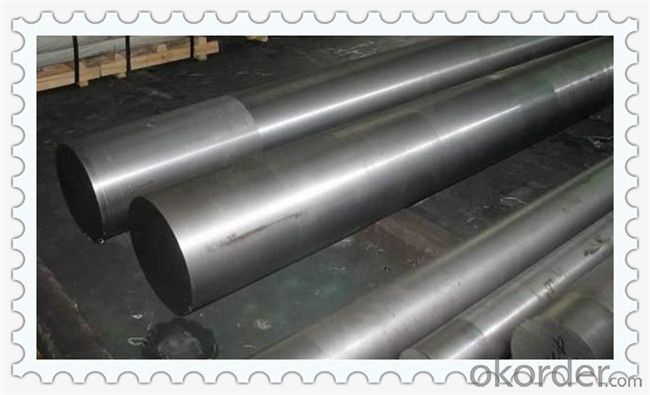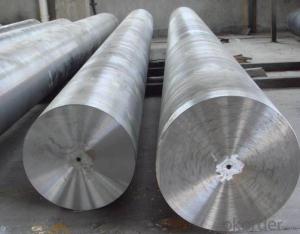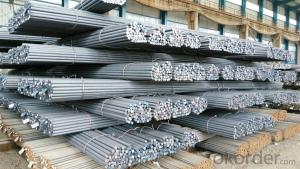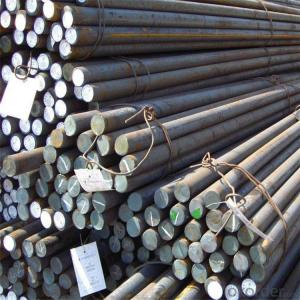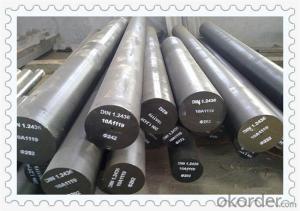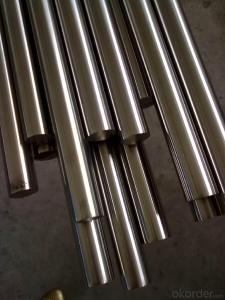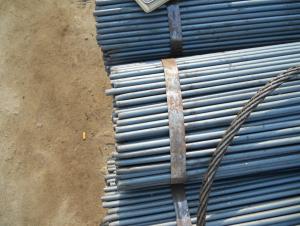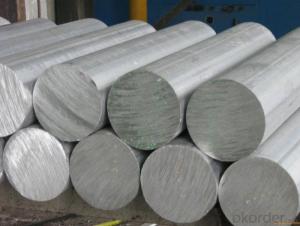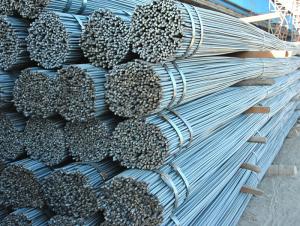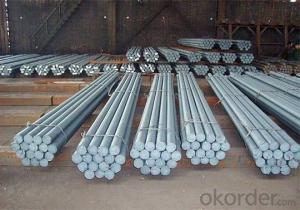AISI 1060 Carbon Steel Round Bars C60
- Loading Port:
- China main port
- Payment Terms:
- TT OR LC
- Min Order Qty:
- 30 m.t.
- Supply Capability:
- 10000 m.t./month
OKorder Service Pledge
OKorder Financial Service
You Might Also Like
AISI 1060 Carbon Steel Round Bars C60
Products Details
Chemical Compostion
Grade | C | Si | Mn | P | S | Cr | Ni |
1055 | 0.50-0.60 | 0.10-0.25 | 0.60-0.90 | Max 0.035 | Max 0.035 | 0.30-0.40 | Max 0.30 |
1060 | 0.57-0.65 | 0.17-0.37 | 0.50-0.80 | Max 0.035 | Max 0.035 | 0.30-0.40 | Max 0.30 |
Mechanical Properties
Grade | Tensile Strength (MPa) | Yield Strength (MPa) | Elongation (%) | Hardness (Annealing) |
1055 | 645 | 380 | 13 | 255 |
1066 | 675 | 400 | 12 | 255 |
Dimentional Range
Hot-rolled | Cold-drawn | Forged | |
Round | 20mm-300mm | 16mm-70mm | 250mm-800mm |
Square | 20*20mm - 130*130mm | 10*10mm-80*80mm | Your requirements |
Flat | Thickness:12mm-100mm Width: 20mm-150mm | Thickness:6mm-70mm Width:16mm-80mm | Your requirements |
Size Tolerances
# Hot-rolled steel round or square bar
d/a(mm) | 5.5-7 | 7-20 | 20-30 | 30-50 | 50-80 | 80-110 | 110-150 | 150-190 | 190-250 |
(mm) | +0.30 -0.30 | +0.35 -0.35 | +0.40 -0.40 | +0.50 -0.50 | +0.70 -0.70 | +1.0 -1.0 | +1.3 -1.3 | +2.0 -2.0 | +2.5 -2.5 |
# Hot-rolled flat bar
Width(mm) | Thickness(mm) | ||||
Size | Size tolerance | Size | Size tolerance | ||
Normal | Better | Normal | Better | ||
10-50 | +0.5, -1.0 | +0.3, -0.9 | 3-16 | +0.3, -0.5 | +0.2, -0.4 |
50-75 | +0.6, -1.3 | +0.4, -1.2 | 16-60 | +1.5% -3.0% | +1.0% -2.5% |
75-100 | +0.9, -1.8 | +0.7, -1.7 | |||
100-150 | +1.0%, -2.0% | +0.8%, -1.8% | |||
Products Show
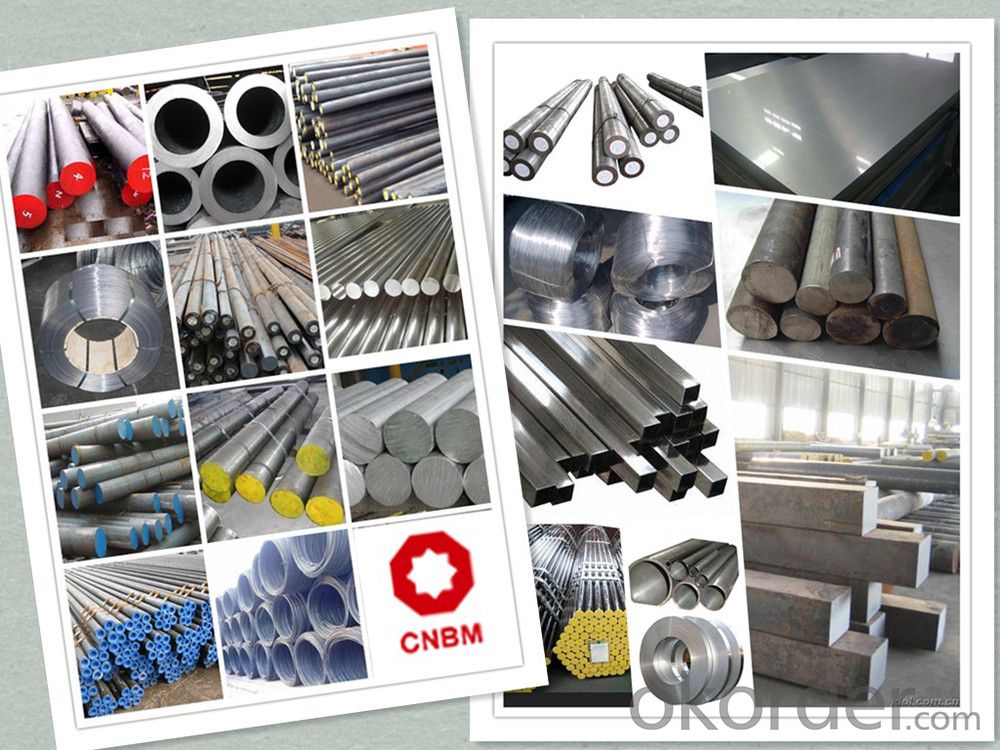
Product Overviews
| Product Name | Typical Grades | Diameter(mm) | Standard adopted |
| Carbon Steel | 20 (1020/S20C/C22) | Ø16-Ø300 |
GB/SAE/JIS/DIN
|
| 40 (1040/S40C/C40) | |||
| 45 (1045/S45C/C45) | |||
| Bearing Steel | GCr9 (51100/SUJ1) | Ø12-Ø250 | |
| GCr15 (52100/SUJ2/100Gr6) | |||
| GCr9SiMn (A485-Gr.1/SUJ3) | |||
Cr-Mo Steel | 20Cr (5120/SCr420H/20Cr4) | Ø12-Ø250 | |
| 40Cr (5140/SCr440/41Cr4) | |||
| 42CrMo(4140/SCM440/42CrMo4) | |||
| Gear Steel | 20CrNiMo | Ø16-Ø600 | |
| 20CrMn(5115/SMnC420/20MnCr5) | |||
| 20CrNiMo(8620/SNCM220/20CrMiMo2) |
Application
| Carbon Steel | Mold bottom, Plastic mold, Construction machinery parts Automobile parts, Security grills, Screens, Construction |
| Bearing Steel | Aerospace, Navigation, Nuclear energy, Chemical industry Electronic information, Petrochemical, Instrument and meter Transportation |
| Cr-Mo Steel | Mechanism & Fasteners gear, Stressed components for vehicles Engines and machines, Parts of larger cross-section |
| Gear Steel | All kinds of gears, Statically and dynamically stressed component for vehicles Engines and machine, Larger cross-section parts, Crankshafts |
Work Shop

Company Information
CNBM International Corporation is the most important trading platform of CNBM group.
Whith its advantages, CNBM International are mainly concentrate on Cement, Glass, Iron and Steel, Ceramics industries and devotes herself for supplying high qulity series of refractories as well as technical consultancies and logistics solutions.


FAQ
1, Your advantages?
professional products inquiry, products knowledge train (for agents), smooth goods delivery, excellent customer solution proposale
2, Test & Certificate?
SGS test is available, customer inspection before shipping is welcome, third party inspection is no problem
3, Factory or Trading Company?
CNBM is a trading company but we have so many protocol factories and CNBM works as a trading department of these factories. Also CNBM is the holding company of many factories.
4, Payment Terms?
30% TT as deposit and 70% before delivery.
Irrevocable L/C at sight.
5, Trading Terms?
EXW, FOB, CIF, FFR, CNF
6, After-sale Service?
CNBM provides the services and support you need for every step of our cooperation. We're the business partner you can trust.
For any problem, please kindly contact us at any your convenient time.
We'll reply you in our first priority within 24 hours.
Packaging & Delivery
1, Packaging: seaworthy package or as required
2, Delivery: 35-45 days or based on quantity
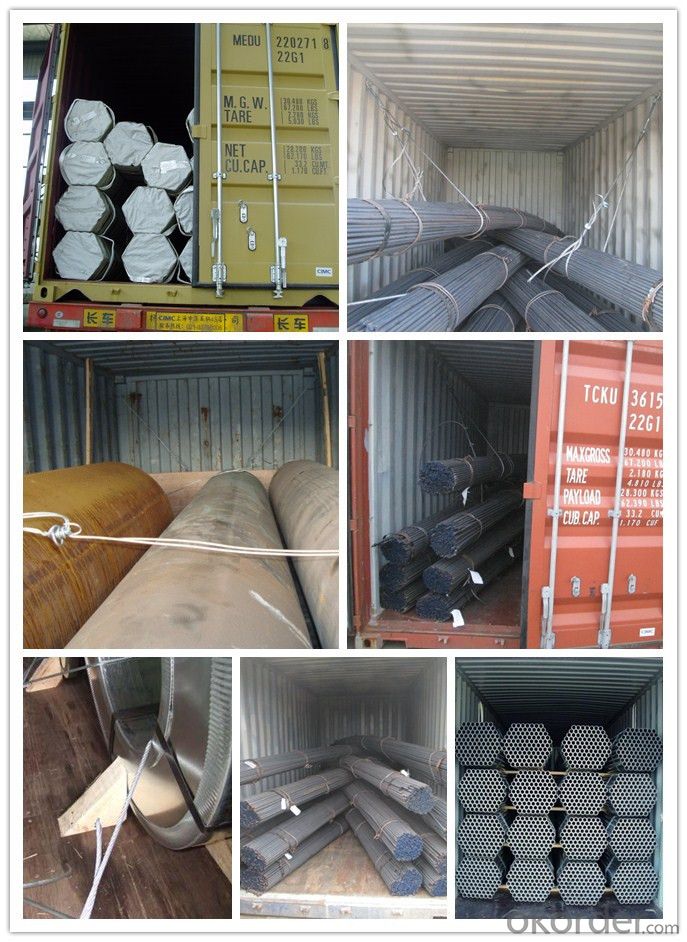
- Q: Can steel round bars be used for making sway bars?
- Yes, steel round bars can be used for making sway bars.
- Q: How do you calculate the weight of a steel round bar based on its length and volume?
- In order to determine the weight of a steel round bar based on its length and volume, it is necessary to have knowledge of the steel's density. The density denotes the mass per unit volume of the material. The weight can be calculated using the following formula: Weight = Volume × Density To begin, one must calculate the volume of the steel round bar. The volume of a cylinder, which is the shape of a round bar, can be determined using the following formula: Volume = π × (Radius)^2 × Length The value of π is a mathematical constant approximately equal to 3.14, and Radius represents the radius of the round bar. Once the volume is obtained, it can be multiplied by the density of the steel to find the weight. It is important to note that the density of steel may vary depending on the specific type being used. For instance, mild steel has a density of approximately 7850 kg/m³. Therefore, the weight of the steel round bar can be calculated as: Weight = Volume × Density For example, let us consider a steel round bar with a length of 1 meter and a radius of 0.5 meters. To calculate the weight, we first need to determine the volume: Volume = π × (0.5)^2 × 1 Volume = 0.7854 m³ Next, we multiply the volume by the density of steel: Weight = 0.7854 m³ × 7850 kg/m³ Weight = 6171.79 kg Hence, the weight of the steel round bar would be approximately 6171.79 kg.
- Q: What are the tolerance standards for steel round bars?
- The tolerance standards for steel round bars vary depending on the specific requirements and industry standards. Generally, the tolerance for diameter or size of steel round bars is specified in terms of a plus or minus tolerance. This means that the actual diameter of the bar can deviate slightly from the specified size, but it should fall within the specified tolerance range. In some industries, such as construction or manufacturing, the tolerance for steel round bars may be relatively broad to allow for easier fabrication and installation. For example, a common tolerance range for the diameter of steel round bars used in construction could be ±0.005 to ±0.010 inches. In more precise applications, such as aerospace or automotive industries, the tolerance requirements for steel round bars are typically much tighter. In these cases, the tolerance range can be significantly smaller, often in the range of ±0.001 to ±0.002 inches. It is important to note that different countries and organizations may have their own specific tolerance standards for steel round bars. These standards are usually outlined in industry-specific documents or specifications, such as ASTM (American Society for Testing and Materials) or ISO (International Organization for Standardization) standards. In summary, the tolerance standards for steel round bars depend on the specific requirements of the industry and application. The tolerance range for diameter can vary from relatively broad to extremely tight, and these standards are typically defined by industry-specific organizations or standards bodies.
- Q: What are the different types of steel round bar machining processes?
- There are several different types of steel round bar machining processes, each with its own unique characteristics and applications. Some of the most common types include: 1. Turning: This process involves rotating the steel round bar against a cutting tool, which removes material to create the desired shape. Turning is often used to create cylindrical shapes or to remove excess material from the surface. 2. Drilling: Drilling is a machining process that involves creating holes in the steel round bar using a rotating cutting tool. This process is commonly used to create holes for bolts or other fasteners. 3. Milling: Milling is a versatile machining process that involves removing material from the surface of the steel round bar using a rotating cutting tool. This process can be used to create complex shapes, slots, or grooves. 4. Grinding: Grinding is a machining process that uses an abrasive wheel to remove material from the surface of the steel round bar. This process is often used to achieve a smooth finish or to remove any imperfections on the surface. 5. Boring: Boring is a process that involves enlarging an existing hole in the steel round bar using a cutting tool. This process is commonly used to create larger diameter holes or to achieve greater precision. 6. Knurling: Knurling is a machining process that involves creating a pattern of ridges or grooves on the surface of the steel round bar. This process is often used to improve grip or to create a decorative effect. 7. Thread cutting: Thread cutting is a process that involves creating external or internal threads on the surface of the steel round bar. This process is commonly used to create threaded holes or to create threaded fasteners. These are just a few examples of the different types of steel round bar machining processes. Each process has its own advantages and limitations, and the choice of which process to use will depend on the specific requirements of the application.
- Q: How do you store excess steel round bars?
- To store excess steel round bars, it is important to follow certain guidelines to ensure their longevity and prevent any damage. Here are a few steps you can take: 1. Properly clean and inspect the steel round bars before storage. Remove any dirt, grease, or moisture from the surface to prevent corrosion. 2. Choose an appropriate storage location. Ideally, it should be a dry, well-ventilated area with stable temperatures. Avoid storing the bars in areas prone to moisture, extreme heat, or direct sunlight. 3. Use racks or pallets to store the bars. Stack them horizontally, one on top of another, with enough space between each layer to prevent deformation or bending. 4. If storing the bars outdoors, cover them with a waterproof tarp or protective coating to shield them from rain, snow, and other elements. 5. Avoid placing excessive weight on top of the bars to prevent deformation. Be mindful of any sharp objects or edges nearby that could cause damage. 6. Regularly inspect the stored bars to ensure no signs of corrosion, rust, or other damage. If any issues are detected, take the necessary steps to address them promptly. Remember, proper storage is crucial to preserve the quality and integrity of the steel round bars. By following these guidelines, you can ensure that your excess steel round bars remain in good condition until they are needed for future use.
- Q: Can steel round bars be used in the manufacturing of jewelry?
- Yes, steel round bars can be used in the manufacturing of jewelry. However, steel is not a common material choice for jewelry due to its hardness and lack of malleability. Other metals such as gold, silver, and platinum are more commonly used for their aesthetic appeal and ability to be easily shaped into intricate designs.
- Q: Can steel round bars be used for making camshafts?
- Yes, steel round bars can be used for making camshafts. Steel is a common material used for camshaft production due to its high strength, durability, and resistance to wear and fatigue. Steel round bars can be machined and shaped into the desired profile, making them suitable for manufacturing camshafts that are critical components in internal combustion engines. The specific type of steel used will depend on the application and performance requirements, but commonly used steels include alloy steels or carbon steels with high mechanical properties. Overall, steel round bars offer a reliable and cost-effective option for producing camshafts that can withstand the demanding conditions of engine operation.
- Q: How are steel round bars used in the manufacturing of agricultural implements?
- Steel round bars are commonly used in the manufacturing of agricultural implements due to their durability, strength, and versatility. These bars are typically made of carbon steel, which provides excellent resistance to wear and tear, making them ideal for heavy-duty applications in the agricultural industry. One of the primary uses of steel round bars in the manufacturing of agricultural implements is in the construction of plows. Plows are essential tools used for breaking up and turning over soil, preparing it for planting. The steel round bars are used to create the main framework of the plow, ensuring it can withstand the high levels of force and pressure exerted while tilling the soil. Steel round bars are also utilized in the manufacturing of harrows, which are used for cultivating the soil after plowing. Harrows are designed to break up clumps of soil, level the ground, and remove weeds, creating an ideal seedbed for planting. The strength of steel round bars allows them to withstand the rigorous use of harrows without bending or breaking, ensuring their longevity and effectiveness. In addition to plows and harrows, steel round bars are commonly used in the fabrication of other agricultural implements such as cultivators, seeders, and sprayers. These implements require sturdy and durable components to withstand the demanding conditions of agricultural operations. Steel round bars provide the necessary strength and structural integrity to these implements, enabling them to perform their intended functions effectively. Furthermore, steel round bars are also used in the manufacturing of livestock equipment such as gates, fences, and cattle panels. These components need to be strong and robust to contain livestock and withstand their movements and force. Steel round bars fulfill these requirements, ensuring the safety and security of animals and the durability of the equipment. Overall, steel round bars play a crucial role in the manufacturing of agricultural implements. Their durability, strength, and versatility make them an ideal choice for creating sturdy and reliable equipment that can withstand the demanding conditions of the agricultural industry.
- Q: What is the maximum titanium content allowed for steel round bars?
- The maximum titanium content allowed for steel round bars typically depends on the specific steel grade and composition. However, as a general guideline, the maximum titanium content in steel round bars is usually around 0.05-0.06%.
- Q: What is the difference between a cold finished and a hot rolled steel round bar?
- The manufacturing processes and resulting properties of a cold finished steel round bar and a hot rolled steel round bar are different. To manufacture cold finished steel round bars, a cold drawing process is used. This involves pulling the steel through a die at room temperature. As a result, the steel has a smooth, polished surface with tight dimensional tolerances. Additionally, the cold drawing process improves the strength, hardness, and overall mechanical properties of the steel. Cold finished steel round bars are commonly used in applications where precision and a smooth surface are important, such as in machinery, automotive parts, and tools. In contrast, hot rolled steel round bars are manufactured by heating the steel to a high temperature and then rolling it through a series of rollers. This allows for shaping and forming while the steel is pliable. Hot rolled steel round bars have a rough, scaled surface and looser dimensional tolerances compared to cold finished bars. They also tend to have slightly lower strength and hardness. Due to their lower cost and ease of production, hot rolled steel round bars are frequently used in construction, structural components, and general fabrication. In summary, the differences between cold finished and hot rolled steel round bars are found in their manufacturing processes and resulting properties. Cold finished bars offer improved strength, precision, and a smooth surface, making them suitable for applications requiring high precision and mechanical performance. On the other hand, hot rolled bars have a rougher surface and looser tolerances, but their affordability and ease of production make them a popular choice for general applications.
Send your message to us
AISI 1060 Carbon Steel Round Bars C60
- Loading Port:
- China main port
- Payment Terms:
- TT OR LC
- Min Order Qty:
- 30 m.t.
- Supply Capability:
- 10000 m.t./month
OKorder Service Pledge
OKorder Financial Service
Similar products
Hot products
Hot Searches
Related keywords

